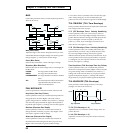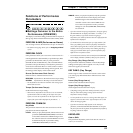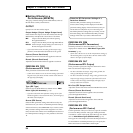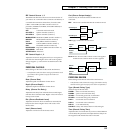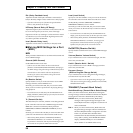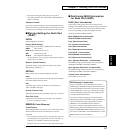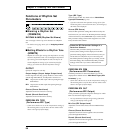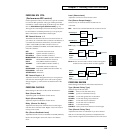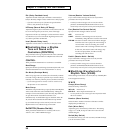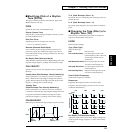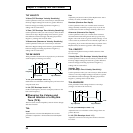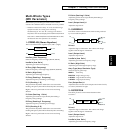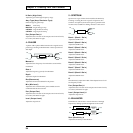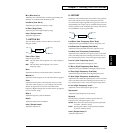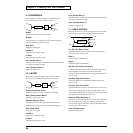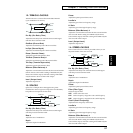
90
Chapter 3. Creating Your Own Sounds
Fbk (Delay Feedback Level)
Adjust the amount of delayed sound that is returned (fed
back) to the delay. Higher values result in more delay repeats.
* If you have selected any one of the Reverb types (ROOM1–
HALL2), this parameter has no effect.
HF Damp (Reverb/Delay HF Damp)
Adjust the frequency above which the reverberant sound will
be cut. As the frequency is set lower, more of the high
frequencies will be cut, resulting in a softer and more muted
reverberance. If you do not want the high frequencies to be
cut, set this parameter to BYPASS.
Level (Reverb/Delay Level)
Adjust the volume of the reverberant (or delayed) sound.
■ Controlling How a Rhythm
Tone will Sound with
Controllers (CONTROL)
The parameters in this group determine how the controllers
function and how instruments in a Rhythm Set will sound.
CONTROL
These parameters determine how each note is controlled.
Bend Range
Specify the amount of pitch change (in semitones) that will occur
when the Pitch Bend Lever is moved (maximum +1 octave).
Env Mode (Envelope Mode)
When a loop-type Wave is selected, it will normally continue
to sound as long as the key is pressed. If you want it to decay
naturally even if the key remains pressed, set this to NO-SUS.
* If a one-shot type Wave is selected, it will not sustain even if
this parameter is set to SUSTAIN.
Mute Group
The Mute Group function lets you specify that certain Rhythm
Tones not be allowed to sound simultaneously. Taking the
example of an acoustic drum set, it is obviously impossible for
an open hi-hat and a closed hi-hat sound to occur
simultaneously. To simulate this type of situation on the XP-
30, set each hi-hat sound to the same Mute Group number.
Up to 31 Mute Groups can be used. If you do not want a
Rhythm Tone to use a Mute Group, turn it OFF.
RxSWITCH (Receive Switch)
These parameters determine how each key will receive
Volume / Pan / Hold 1 MIDI messages.
Volume (Receive Volume Switch)
If you want Volume messages to be received, turn this
parameter ON. If not, turn it OFF.
* In order for Volume messages to be received, the Volume
parameter (PERFORM/MIDI/RxSWITCH) must also be
turned ON for Part 10 of the currently selected Performance.
Pan (Receive Pan Control Switch)
Specify how Pan messages will be received.
OFF: Not received.
CONT:
Whenever a Pan message is received, it will
immediately change the stereo location of the sound.
KEY-ON: The stereo location of the sound will be changed
when the next note is played. If a Pan message is
received while a note is sounding, the current
stereo location will not change until the next note.
In this case, the stereo location will change only
for the note played later, and the currently
sounding note will not move.
Hold-1 (Receive Hold 1 Switch)
If you want Hold 1 messages to be received, turn this
parameter ON. If not, turn it OFF.
* In order for Hold 1 messages to be received, the Hold-1
parameter (PERFORM/MIDI/RxSWITCH) must also be
turned ON for Part 10 of the currently selected Performance.
■ Modifying Waveform of a
Rhythm Tone (WAVE)
Make settings for the basic waveform (Wave) of the Rhythm
Tone assigned to each key.
WAVE
Group (Wave Group)
Select the Group of the Wave.
INT-A, B: Internal A, B
EXP-A–E: Wave Expansion Boards A–E
* It is not possible to select a Group of a Wave Expansion Board
that is not installed.
Number (Wave Number)
Select the Wave number. The name of the Wave will be
displayed in parentheses ( ).
Gain (Wave Gain)
Adjust the gain (volume boost) of the Wave. The setting
range is -6–+12 dB, in steps of 6 dB. An increase of 6 dB
doubles the gain.
Switch (Key Switch)
Turn this ON for keys you wish to sound, and OFF for keys
you do not wish to sound.



